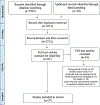Maternal gut microbiota in the postpartum Period: A Systematic review
- PMID: 37116306
- PMCID: PMC10320739
- DOI: 10.1016/j.ejogrb.2023.03.042
Maternal gut microbiota in the postpartum Period: A Systematic review
Abstract
Studies have demonstrated the importance of the gut microbiota during pregnancy, and there is emerging literature on the postpartum maternal gut microbiota. The primary objective of this paper was to synthesize the literature on the postpartum gut microbiome composition and diversity measured in stool samples from healthy mothers of predominantly term infants. The secondary objectives were (1) to identify biological and environmental factors that influence postpartum maternal gut microbiota and (2) to assess health conditions and clinical intermediate measures associated with postpartum gut microbiota changes in all mothers. Electronic searches were conducted November 9, 2020 and updated July 25, 2021 without publication time limits on PubMed, Embase, CINHAL, Scopus, Cochrane Library, BioArchives, and OpenGrey.eu. Primary research on maternal gut microbiota in the postpartum (up to one year after childbirth) were eligible. Postpartum gut microbiota comparisons to pregnancy or non-pregnancy gut microbiota were of interest, therefore, studies examining these in addition to the postpartum were included. Studies were excluded if they were only conducted in animals, infants, pregnancy, or microbiome of other body locations (e.g., vaginal). Data extraction of microbial composition and diversity were completed and synthesized narratively. Studies were assessed for risk of bias. A total of 2512 articles were screened after deduplication and 27 were included in this review. Of the 27 included studies, 22 addressed the primary objective. Firmicutes was the predominant phylum in the early (<6 weeks) and late postpartum (6 weeks to 1 year). In early postpartum, Bacteroides was the predominant genus. Findings from longitudinal assessments of alpha and beta diversity from the early to the late postpartum varied. Nineteen of the 27 studies assessed biological and environmental factors influencing the postpartum gut microbial profile changes. Timing of delivery, probiotic supplementation, triclosan exposure, and certain diets influenced the postpartum gut microbiota. Regarding health conditions and intermediate clinical measures assessed in 8 studies; inflammatory bowel disease, postpartum depression, early-onset preeclampsia, gestational diabetes, excessive gestational weight gain, and anthropometric measures such as body mass index and waist-to-hip ratio were related to gut microbiota changes. There is limited data on the maternal postpartum gut microbiota and how it influences maternal health. We need to understand the postpartum maternal gut microbiome, establish how it differs from non-pregnancy and pregnancy states, and determine biological and environmental influencers. Future research of the gut microbiome's significance for the birthing parent in the postpartum could lead to a new understanding of how to improve maternal short and long-term health.
Keywords: Gut microbiome; Maternal; Microbiome; Microflora; Postpartum; Women.
Copyright © 2023 Elsevier B.V. All rights reserved.
Conflict of interest statement
Declaration of Competing Interest The authors declare that they have no known competing financial interests or personal relationships that could have appeared to influence the work reported in this paper.
Figures

References
Publication types
MeSH terms
Grants and funding
LinkOut - more resources
Full Text Sources

